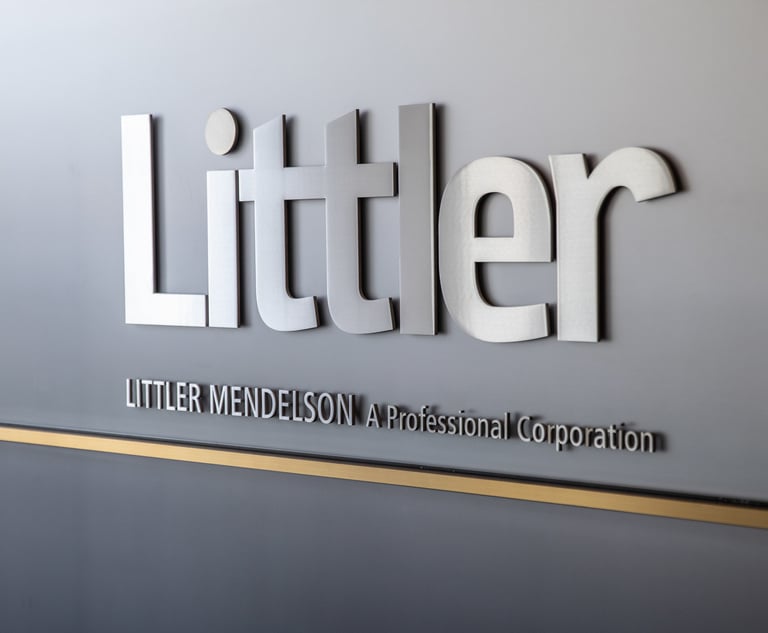The Deep Value of Law Firm Alignment
Only when each part of a firm is working toward the same business goals can it truly flourish.
October 23, 2018 at 12:41 PM
6 minute read

When it comes to law firm performance, does alignment matter? The answer is an emphatic yes. In our collective 65 years entrenched in law firms, we've seen well-aligned firms soar and succeed while poorly aligned firms have foundered and failed. But what exactly do we mean by alignment and why is it important?
There are law firms where everything is in sync. Like the vertebrae in a well-formed spine, elements of the business seem aligned. Members of the firm's leadership team have collaborated to create a very clear business strategy and they've communicated that vision throughout the partnership and associate and administrative ranks. The partnership has worked together to support the strategy through a host of appropriate tactics: developing new practice areas, forming a firmwide compensation system in support of a mission, and fostering a culture allowing them to retain and develop top professionals and talented staff. For partners, they've put into place both extrinsic (compensation) and intrinsic (peer approval) rewards to reinforce those behaviors the firm prizes. These firms have agreed on a purpose and have established a plan for healthy growth.
Then there are firms that have no alignment. Management may once have developed a detailed strategy to achieve growth, but never got around to communicating the strategy to associates or support staff. They continue to fund programs that fall outside of the strategy and delay making changes to their compensation structure to support the new goals, because, as they say, it's “just too much to handle right now.” The firm's leadership prefers not to bring their C-suite executives into the picture, except on a need-to-know basis.
Alignment is more than an orthopedic objective or a marketing buzzword. Alignment is an essential principle for a law firm's survival.
In past years, alignment may not have been a requisite for success. In fact, a certain amount of misalignment was accepted.
In the pre-2008 years, significant annual demand growth of almost 4 percent and rate increases enabled most firms to achieve double-digit revenue growth without breaking much of a sweat. These seemingly healthy dynamics actually masked underlying problems at many firms. These firms succeeded despite misalignment. In the new world order where law firm clients have many more options, firms simply cannot afford the luxury of misalignment. In this tepid demand growth environment where rate increases have been less than half the levels enjoyed during the earlier period, there will be winners and losers. And we believe alignment is the key differentiator.
Research demonstrates that there is a strong correlation between an organization's success and the amount of focus it places on organizational health. Focusing on health involves managing alignment based on creating a common vision, providing tactics to execute on that vision, and constantly innovating to bring new ideas and improvement to the organization.
According to McKinsey & Co., organizations that work on these aspects not only achieve long-term measurable improvements in their organizational well-being, but by starting to focus on alignment, companies demonstrate tangible performance gains in as little as six to 12 months. In Deborah's work interviewing more than 55 professionals for her book “Best Practices for Law Firm Business Development and Marketing,” she found that those law firms with leaders who could easily talk about how the various elements of vision, culture and compensation worked together were more likely to lead firms that were profitable and had a better outlook for a long-term future.
McKinsey's research for its Organizational Health Index shows a strong correlation between a firm's culture and its performance. Firms that align their compensation and other recognition methods with their key goals and objectives, demonstrate a high degree of transparency and reinforce their vision with communications are more likely to demonstrate success than those that are merely average.
Alignment applies to large, multi-practice firms and small firms alike. How does a firm's management begin to put alignment into place? Some ways to begin include:
- Operational and marketing tactics should all be based on a well-defined and articulated strategy.
- Strategy must be communicated, up and down the organization. Sharing strategy both with direct reports and throughout the organization leads to greater loyalty, a shared sense of purpose, and collaboration. The time spent communicating these decisions is an investment that pays off in multiples.
- C-suite members should have a role on the executive committee to provide input in the development of the firm's strategy and vision. Not only will C-suite involvement build loyalty, these executives will be allies in plan implementation.
- Compensation metrics should be transparent and reward those behaviors that a firm values. Consider rewarding not just for business development activity, but where there is collaboration across all practice areas.
- During compensation time, look at qualitative metics for more than simply self-reporting. Consider asking partners not only to self-report, but to answer assessment questions, such as: “Over the past year, which partner outside of your practice, helped you build your practice the most?” Third-party recognition will give a more robust picture.
- Leaders of the firm, practice areas and committees should be those who emulate the values of the firm and further its strategic mission. Bad behavior that goes against firm policies and standards puts the firm at risk, erodes culture and communicates a message that the mission is not a serious one.
Firms can no longer afford to think that aspects of a business are purely tactical. There is too much at stake. Costs are high and competition is intense. Every tactic needs to branch out from a carefully defined core strategy. Culture and strategy need to be aligned and to reach all of the bones of an organization. Getting alignment right leads to superior performance; getting it wrong leads to places better not to contemplate.
Deborah Farone is a strategy consultant at Farone Advisors and author of “Best Practices in Law Firm Marketing and Business Development.” Dan DiPietro is principal at Dan DiPietro Consulting.
This content has been archived. It is available through our partners, LexisNexis® and Bloomberg Law.
To view this content, please continue to their sites.
Not a Lexis Subscriber?
Subscribe Now
Not a Bloomberg Law Subscriber?
Subscribe Now
NOT FOR REPRINT
© 2025 ALM Global, LLC, All Rights Reserved. Request academic re-use from www.copyright.com. All other uses, submit a request to [email protected]. For more information visit Asset & Logo Licensing.
You Might Like
View All

Three Akin Sports Lawyers Jump to Employment Firm Littler Mendelson

Brownstein Adds Former Interior Secretary, Offering 'Strategic Counsel' During New Trump Term
2 minute read
Trending Stories
Who Got The Work
J. Brugh Lower of Gibbons has entered an appearance for industrial equipment supplier Devco Corporation in a pending trademark infringement lawsuit. The suit, accusing the defendant of selling knock-off Graco products, was filed Dec. 18 in New Jersey District Court by Rivkin Radler on behalf of Graco Inc. and Graco Minnesota. The case, assigned to U.S. District Judge Zahid N. Quraishi, is 3:24-cv-11294, Graco Inc. et al v. Devco Corporation.
Who Got The Work
Rebecca Maller-Stein and Kent A. Yalowitz of Arnold & Porter Kaye Scholer have entered their appearances for Hanaco Venture Capital and its executives, Lior Prosor and David Frankel, in a pending securities lawsuit. The action, filed on Dec. 24 in New York Southern District Court by Zell, Aron & Co. on behalf of Goldeneye Advisors, accuses the defendants of negligently and fraudulently managing the plaintiff's $1 million investment. The case, assigned to U.S. District Judge Vernon S. Broderick, is 1:24-cv-09918, Goldeneye Advisors, LLC v. Hanaco Venture Capital, Ltd. et al.
Who Got The Work
Attorneys from A&O Shearman has stepped in as defense counsel for Toronto-Dominion Bank and other defendants in a pending securities class action. The suit, filed Dec. 11 in New York Southern District Court by Bleichmar Fonti & Auld, accuses the defendants of concealing the bank's 'pervasive' deficiencies in regards to its compliance with the Bank Secrecy Act and the quality of its anti-money laundering controls. The case, assigned to U.S. District Judge Arun Subramanian, is 1:24-cv-09445, Gonzalez v. The Toronto-Dominion Bank et al.
Who Got The Work
Crown Castle International, a Pennsylvania company providing shared communications infrastructure, has turned to Luke D. Wolf of Gordon Rees Scully Mansukhani to fend off a pending breach-of-contract lawsuit. The court action, filed Nov. 25 in Michigan Eastern District Court by Hooper Hathaway PC on behalf of The Town Residences LLC, accuses Crown Castle of failing to transfer approximately $30,000 in utility payments from T-Mobile in breach of a roof-top lease and assignment agreement. The case, assigned to U.S. District Judge Susan K. Declercq, is 2:24-cv-13131, The Town Residences LLC v. T-Mobile US, Inc. et al.
Who Got The Work
Wilfred P. Coronato and Daniel M. Schwartz of McCarter & English have stepped in as defense counsel to Electrolux Home Products Inc. in a pending product liability lawsuit. The court action, filed Nov. 26 in New York Eastern District Court by Poulos Lopiccolo PC and Nagel Rice LLP on behalf of David Stern, alleges that the defendant's refrigerators’ drawers and shelving repeatedly break and fall apart within months after purchase. The case, assigned to U.S. District Judge Joan M. Azrack, is 2:24-cv-08204, Stern v. Electrolux Home Products, Inc.
Featured Firms
Law Offices of Gary Martin Hays & Associates, P.C.
(470) 294-1674
Law Offices of Mark E. Salomone
(857) 444-6468
Smith & Hassler
(713) 739-1250









